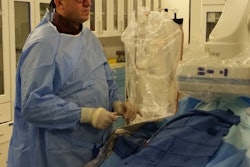
There are five key steps that should be taken to improve the provision of interventional radiology in Europe. That's according to a new survey of European interventional radiology departments published February 13 in Insights into Imaging.
While the use of interventional radiology is growing as a less-invasive alternative to open surgery, the field is not as healthy in Europe as it could be, according to the survey, which was performed as part of a collaboration between the European Society of Radiology (ESR) and the Cardiovascular and Interventional Radiological Society of Europe (CIRSE).
For example, there is a widespread shortage of interventional radiologists that makes it difficult for some facilities to provide off-hours coverage for emergencies. This raises the risk that other specialties could move in to perform interventional procedures themselves, as cardiologists have largely done with cardiac procedures, wrote co-authors Dr. Lorenzo Derchi and Dr. Afshin Gangi, PhD, on behalf of the ESR and CIRSE (Insights Imaging, February 13, 2019).
To learn more about these trends, the societies began working together in 2017 on an initiative to strengthen the bonds between diagnostic and interventional radiology. Part of that effort was to commission a survey that was launched in May 2017 to query European radiology departments on the practice of interventional radiology in their facilities. In all, 98 radiology department heads completed the survey, for a response rate of 8.3%.
Responses to the survey came from a variety of European countries and from hospitals of various sizes. A majority (52%) of the responses were from hospitals with more than 800 beds; only four hospitals with fewer than 199 beds responded. The vast majority of responses -- 94.9% -- were from academic facilities that had radiologists-in-training.
Questions ranged from the number of interventional radiologists working in departments to the types of procedures performed, as well as whether interventionalists tended to subspecialize in certain types of procedures. Other questions asked about the gender of interventional radiologists and the extent to which the service provided 24-hour coverage.
The researchers found a number of challenges facing European interventional practices, all of which had a common theme: namely, that not enough interventional radiologists are being trained to meet a growing demand.
Based on the results, the authors recommended five steps to improve the provision of interventional radiology in Europe:
- All acute care hospitals should prioritize offering 24-hour interventional radiology coverage. In Europe, about 60% of radiology departments can cover interventional emergencies, a percentage that the study authors believe is too low. If a hospital does not have enough interventionalists on staff for 24-hour coverage, hospitals within regions could form networks to share resources.
- Interventional radiology should be promoted to medical students early in their training as a viable career option. Research in the U.S. has shown that far fewer medical students were exposed to interventional radiology compared to diagnostic radiology; this can hamper recruitment to the specialty. Only by attracting more trainees can interventional radiology overcome the personnel shortages that are restricting its broader use.
- More women must be recruited into interventional radiology. While about half of diagnostic radiologists at European hospitals are women, they make up a "small minority" at facilities dedicated to interventional radiology, the researchers found (this is also an issue in the U.S.). They attributed the gender imbalance to concerns about call responsibilities and the lack of role models, which they believe could be counterbalanced by increasing the number of women in interventional faculty and chair positions.
- Radiology should recognize the full clinical role of interventional radiology. This could be through the allocation of enough day-case beds to accommodate interventional procedures, for example, or through recognition of the administrative responsibilities involved in the full episode of care for patients treated with interventional procedures, such as patient examinations.
- Diagnostic radiologists should take a more active role in interventional radiology. This could include actions such as recommending referrals to interventional colleagues in radiology reports when appropriate and sharing knowledge with diagnostic radiologists about interventional procedures.
"The main cause of the problem ... is a significant shortage of interventional radiologists," the authors concluded. "Both [the ESR and CIRSE] believe that this problem may lead to a loss of ground of [interventional radiology] toward other medical specialties and make the specialty of radiology, as a whole, more fragile."



















